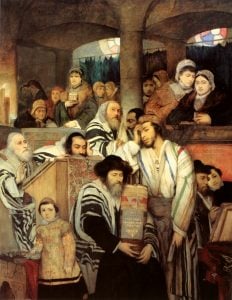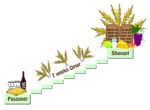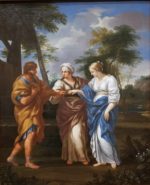Ten Systems—Ten Sefirot
… mi‑b’sari echezeh Elokah—From my flesh I behold G‑d (Job 19:26) Introduction – “In His Image” The Torah’s initial description of humanity is both profound and enigmatic:
… mi‑b’sari echezeh Elokah—From my flesh I behold G‑d (Job 19:26) Introduction – “In His Image” The Torah’s initial description of humanity is both profound and enigmatic:

Introduction In this essay, I intend to draw a parallel between the singularity in space-time, such as the putative point of origin of the universe
Zealotry and Mercy: Parallels Between Pinchas and the War in Gaza The biblical story of Phinehas (Heb. Pinḥas or Pinchas) presents a complex moral scenario

The Temple Menorah served as a lighthouse, illuminating darkness and providing purpose and direction.

The spectacle of the universe becomes so much the grander, so much more beautiful, the worthier of its Author, when one knows that a small

The forty-nine days between Passover and Shavuot are called the days of Sefira or the days of counting Omer—Sefirat HaOmer—when Jews count every day as

This is the fourth installment in the series of essays on the nature of the soul. The first three installments can be found here: What

…[H]e who tries to cure the soul, wishing to improve the moral qualities, must have a knowledge of the soul in its totality and

In the biblical story of the creation of Adam, the Torah states: Then the Eternal G‑d formed man of the dust of the ground, and

Now the earth was unformed and void. Genesis 1:2 We have a big problem in cosmology: the problem of the initial conditions of the universe at

Yom Kippur means “The Day of Atonement.” Some view it as a frightening day full of regrets of the past and anxiety for the future.

We are quite familiar with space—we move freely in space back and forth; we concur space on land and beyond; we reclaim land from sea;

Now Laban had two daughters: the name of the elder was Leah, and the name of the younger was Rachel. (Genesis 29:16) Rabbi Isaiah Horowitz (the

So Abram went, as the Eternal had spoken unto him; and Lot went with him… And Abram took Sarai his wife, and Lot his brother’s

For the life of the flesh is in the blood.” (Leviticus 17:11) The word translated here as “life” in the Hebrew original is nefesh, i.e.,

There is a Biblical Commandment to count the days between the Passover and Shavuot, the “Feast of Weeks” (a.k.a. Pentecost). We start counting on the

The Torah portion Vayakhel deals with the construction of the Mishkan, i.e., the “Tabernacle.” In Kabbalah, the Mishkan is viewed as a microcosm that represents

As we discussed in the previous post “Singularity and Paradise,” Paradise offers a beautiful metaphor for modern cosmology wherein Eden is the initial singularity preceding

These are the chronicles of the heaven and of the earth when they were created, in the day that the Eternal G‑d made earth and

As we discussed in the earlier post, The Tree of Knowledge as a Metaphor for Superposition of States and Heisenberg’s Uncertainty Principle, the Heisenberg uncertainty

And the Lord spoke unto Moses, saying: ‘Command the children of Israel, and say unto them: When ye come into the land of Canaan, this

Meditations on the Maaseh Merkavah – I We do science by studying nature. We study physics in a lab, peering into space or working out

The Special Theory of Relativity, published by Albert Einstein in 1905, was a game changer. It ushered the era of new physics dubbed by some
The previous Lubavitcher Rebbe, the Rebbe Rayatz (a.k.a. the Fridriker Rebbe) told the story about his father, the Rebbe Rashab. Once the brother of Rebbe

And Moses turned, and went down from the mount, with the two tablets of the testimony in his hand; tablets that were written on both

Now, therefore, write ye this song for you, and teach thou it the children of Israel.” (Deut. 31:19) The four known fundamental forces are: gravitational
In the Torah portion Emor (Leviticus 21:1–24:23), we are instructed to abstain from work every seventh day on Shabbat. Next week’s Torah portion, Behar, continues
Last week Torah portion, Emor, speaks about the prohibition of working on Shabbat. In fact, the Talmud enumerates precisely 39 categories of labor forbidden on
We all know that we leave in a three-dimensional world. Up-down, right-left, forward-backward – these are well-familiar to us directions in three dimensions of space
In this Torah portion, Vayechi, Jacob, gathers his children to reveal to them “Ketz HaYamim”–“the End of Days.” Rashi explains that Jacob’s intention was to

I grew up in Russia and was raised on the metric system based on decimal arithmetic. When we immigrated to the U.S., I had to

These are the journeys of the children of Israel… (Numbers 33:1) When G-d brought the Jews out from Egypt, He brought them out with the mystery of
Speak unto Aaron, and say unto him: “When thou lightest the lamps, the seven lamps shall give light in front of the menorah.” (Num. 8:1)
The holiday of Passover – Pesach – is called zman cheruteinu– time of our freedom. As we have discussed many times on this blog (see

Reading the Torah, sometimes, can give a false impression of reading a story, albeit the greatest story ever written. This Divine drama involves colorful characters,
This Rosh HaShanah I had the strangest dream. I dreamed that I was giving a lecture in cosmology at a university when I suddenly realized